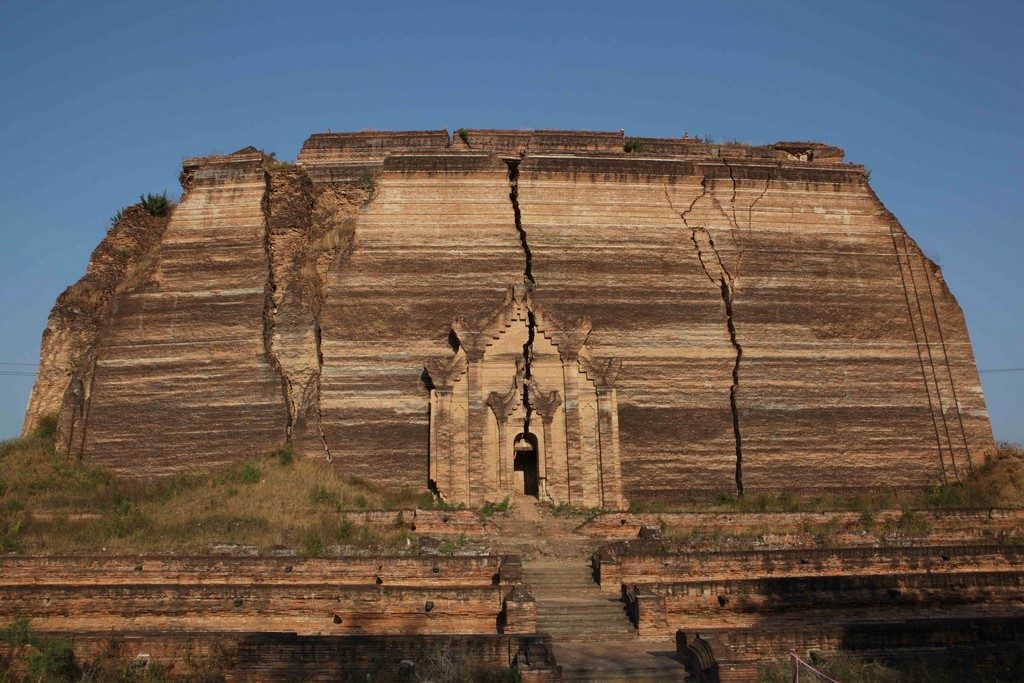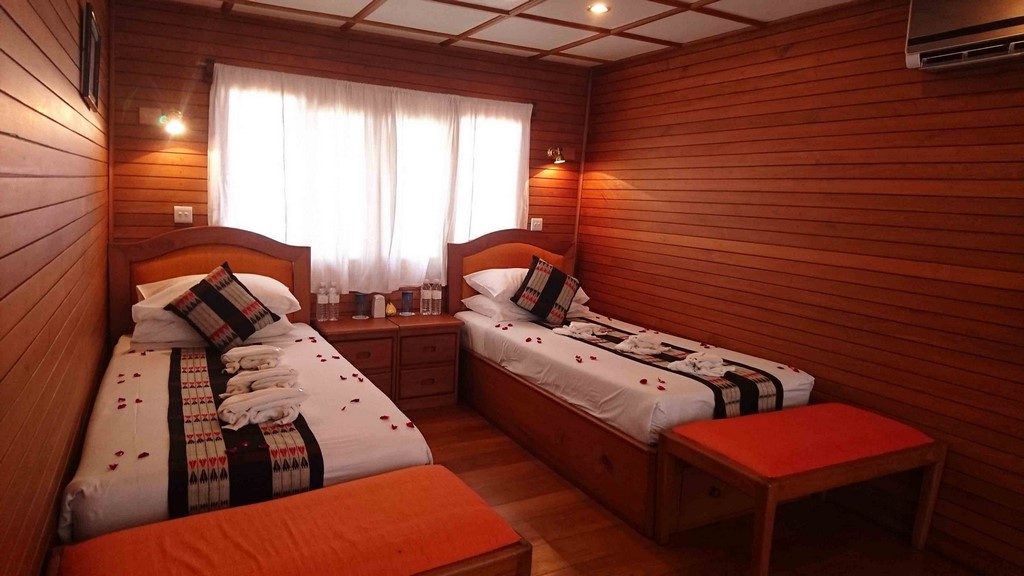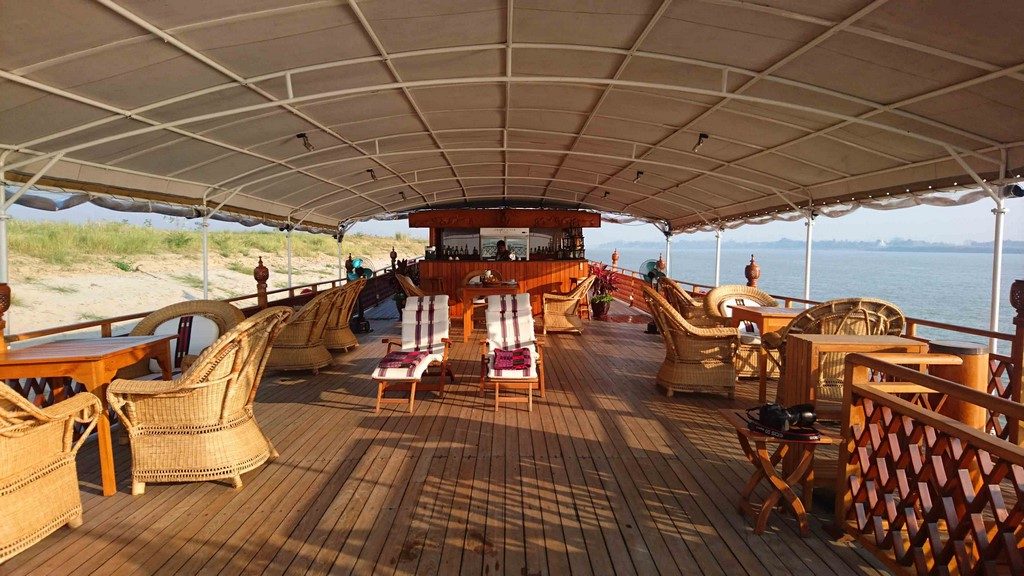
This is one of Burma?s most interesting and least popular river cruises. From golden pagodas to monasteries, from forests to rice paddies, from the fantastic to the unreal, the Irrawaddy reveals its world of beliefs and superstitions. Welcome to the land of gods and genies.
Our journey begins in Bhamo, a small town in northern Burma, in the state of Kachin. It is also the last port before the Chinese border, some 90 km away. We get a feel for the town by taking a tour of the market, where a large number of Chinese traders set up shop. They dominate the trade in everyday goods and, above all, the less visible, informal trade in contraband. Jade, precious stones and wood: "every year, billions of dollars escape the Burmese economy", says our guide.
The population, a mixture of Shan and Kachin ethnic groups, makes the best of it, and even gets a few subsidies. In Myanmar, per capita income remains one of the lowest in the world.
Before boarding our ship, the Amara II, which is waiting for us at the quayside, we make a few purchases: a longyi, a kind of long cylindrical skirt worn by both sexes - practical as it is forbidden for both sexes to show their knees in pagodas - and flip-flops as we are constantly taking our shoes off, whether on the boat or in the temples.
 Street vendor at Bhamo market.
Street vendor at Bhamo market.
The welcome on board is extremely attentive, and with good reason: we will be the last and only passengers on this final cruise of the dry season, with a crew of 11.
We are given the central cabin, "recently occupied by the King of Norway", reveals the onboard manager. It's a little more spacious than the other 4, but all are very functional and dressed in teak.
A commercial artery
It will take us 8 days to reach Mandalay, Burma's second largest city. Going upriver in the opposite direction takes twice as long. In the dry season, night navigation is impossible. So our nights will be peaceful.
The boat leaves the shore, which isn't very busy on this mild afternoon, and heads gently at 5-6 knots to reach our first wild anchorage. It's early March and the river is dotted with numerous sandbanks. Depending on the season, the river is more or less dotted with islets and divided into numerous arms.
 Two sailors are constantly sounding the water with a long bamboo rod, while another looks out for floating objects (trunks, trees) and informs the bridge of the depth by gesture: 3 fingers raised correspond to a water depth of 3 cubits, 3 fingers and thumb at right angles mean 3 and a half cubits, whole hand raised: 5 cubits, etc.
Two sailors are constantly sounding the water with a long bamboo rod, while another looks out for floating objects (trunks, trees) and informs the bridge of the depth by gesture: 3 fingers raised correspond to a water depth of 3 cubits, 3 fingers and thumb at right angles mean 3 and a half cubits, whole hand raised: 5 cubits, etc.
The captain, Nyunt Lwyn (58), has been sailing the Irrawaddy (Ayeryarwaddy in Burmese) for some forty years and knows its every twist and turn. But he remains on his guard. It takes years to get to know the river, but you are often surprised," he says. The river is alive, it changes with the seasons and this year a village of straw huts had to move 500m because the banks had crumbled. In places, the sand cliffs can be 5 or 6 metres high.
 Some benches are permanent and the villagers have set up permanent camps right in the middle of the riverbed.
Some benches are permanent and the villagers have set up permanent camps right in the middle of the riverbed.
This brown wave with its silver reflections seems peaceful at low water, but after the monsoon rains, the river undermines the sandy banks, which recede a little further each year. The river then shrinks from a width of 1 or 2km, depending on the place, to around 4km.
Like the Ganges for the Indians, the Irrawaddy is sacred. Sailors offer it flowers, lanterns and prayers. Thousands of whitewashed stupas and gold-covered pagodas line its banks, housing relics of saints and statues of Buddha.
 It's also a living museum of everything that can float: packed barges, bamboo or teak rafts, ships belching black smoke, ferries in an improbable state, fishermen's boats, passenger launches, etc.
It's also a living museum of everything that can float: packed barges, bamboo or teak rafts, ships belching black smoke, ferries in an improbable state, fishermen's boats, passenger launches, etc.
First ports of call
The next morning, we set off again for Shwegu. In the light rain, we pass through the 2nd defile, a channel around 100m long, wedged between sheer cliffs over 200m high. Spectacular! Four channels punctuate the Irrawaddy as far as the Andaman Sea. The first is not navigable, so we go around it. We cross the other three.
From a landscape of sandy plains we migrate to an environment of steep forests, then banks dotted with groves and tiny villages on stilts. The Burmese forest, which covers almost half the country, is shrinking every year. The main causes are the illegal trade in precious woods (particularly rosewood and ironwood, which cannot be cultivated like teak) and deforestation for agricultural purposes. Added to this is the poverty of the villagers, who are forced to cut wood for cooking or to sell it illegally to neighbouring countries (notably China). The riverbanks are dotted with piles of bamboo stalks and teak logs awaiting transport.
 The bamboo is assembled into giant rafts before being transported down the river.
The bamboo is assembled into giant rafts before being transported down the river.
We stop off at the village of Sin Kan (population 6,000), where the streets are made of mud. The women wash their children and clothes on the riverbank.
 At the market, we are offered betel leaves and areca nuts to chew.
At the market, we are offered betel leaves and areca nuts to chew.
Here, half the men and a quarter of the women chew tobacco. You can tell by their reddened teeth and lips. But few know that the plant is carcinogenic and addictive.
A few kilometres downstream, we spot a group of gold miners on the bank. A powerful pump is sucking up the bottom of the river. The only problem is that they use mercury with their bare hands to amalgamate the gold, and the wash water is discharged into the river, which is highly toxic to the food chain.
 At the bottom of a water hole, a family wields paddles in search of the nuggets that will make them rich.
At the bottom of a water hole, a family wields paddles in search of the nuggets that will make them rich.
The afternoon is devoted to a visit to the Shwegu pagoda, where a popular festival attracts thousands of pilgrims. The stupas of the old pagoda are in ruins. Built of bricks and sand, they have not withstood the elements and the vegetation that has grown over them. But a new one has been built next door.
A daily life punctuated by religion
 Family prayer at the Schwedagon pagoda in Rangoon
Family prayer at the Schwedagon pagoda in Rangoon
Pilgrimages are legion and often provide an opportunity for a little rest for a people who never go on holiday.
Families pray, eat and sleep in front of the altars on the floor, with their heads turned towards the Buddha figures. Devotees prostrate themselves before the statues, while monks and nuns meditate and collect offerings.
The third day of sailing got off to a cool start, under a light mist. The river leaves its north-south orientation and begins to curve in an east-north-west direction. It then gradually widens. The sandy cliffs, topped by a few huts with wild grass or corrugated iron roofs, taper off to make way for food crops. Halfway to Katha, the river flows north-south again and the sun breaks through the clouds. We are lucky enough to see three Irrawaddy dolphins frolicking around the Amara II.
Navigation is slow due to the numerous sandbanks and shoals that force sailors to sound.
In the footsteps of Orwell
Katha is proud to have been home to the writer George Orwell, who lived in this peaceful village between 1926 and 1927 while serving in the Imperial Police. He even used it as the backdrop for his first novel, Burmese Days. We visit some of the places where he lived. Here, his teak house, the first floor of which is currently occupied by the family of a police officer. The building is in a sorry state and the garden is in a similar state. In another part of the city, we discover the British Club, where the colonial society of the time used to meet, and where the natives were not allowed in unless they were serving. It has been out of use for ages, and you have to find the key before entering a dusty room with faded teak walls. It's hard to imagine that this place was once a daily meeting place for Westerners who came here to drown their boredom in alcohol.
There's nothing like a trip to the market to get a feel for the place.
As evening falls, our captain decides to move away from the city and moor up on an island where a delicious candlelit barbecue awaits us.
Villages frozen in time
The next day, we continue on to Tagaung, one of Burma?s oldest capitals. But first, we stop off in a tiny village with an ancestral way of life, where we are a curiosity for the locals.
 Barefoot pushcarts, harnessed cattle, straw huts on stilts, houses made of wood and bamboo mats - progress has never touched these lands, which are only accessible by boat.
Barefoot pushcarts, harnessed cattle, straw huts on stilts, houses made of wood and bamboo mats - progress has never touched these lands, which are only accessible by boat.
Every time you dock, you will appreciate the skilful way in which the captain handles his ship. Because of the wide variations in water levels, there are virtually no fixed pontoons along the river.
 To disembark, wooden gangways are laid between the shore and the gunwale.
To disembark, wooden gangways are laid between the shore and the gunwale.
 Before Tagaung, the river widens and once again laps the sandbanks bordering the rice fields.
Before Tagaung, the river widens and once again laps the sandbanks bordering the rice fields.
Time passes peacefully, to the slow rhythm of navigation punctuated by the gongs and chants emanating from the many monasteries.
As the sun reddens the horizon and lights up the sandy shores, the captain guides the boat to a large sandbank that will serve as an anchorage for the night.
Timeless Burma
Early the next morning, the Amara heads back towards Thabeikkyin, where the river crosses its third gorge, carved out of sandstone. The vegetation changes. There are burnt areas on some of the hills, blackish crusts drowned out by a sparse landscape of dry trees. About forty years ago, these hills were covered in natural teak," comments our guide. The farmers have cut down everything and planted nothing. Some of them still make charcoal with the rest of the trees. It's the only way they can survive.
Stopover in the pottery village of Nwe Nyein
The Tagaung region has been renowned since the mid-18th century for its magnificent glazed pottery. The craftsmen take us on a tour of their workshops and their brick and clay kilns, where the week's firing takes place.
The jars, known here as Ali Baba pots, are transported by raft or boat to Mandalay or Bagan. They are used to store water and oil in houses.
For the night, we stay close to the ancient capital of Kyaukmyaung. This is a great opportunity to see the bustle of this town, with its myriad street vendors jumping from one passenger boat to another, children diving into the brown water and monks strolling along the river.
We meet a young nun, dressed all in pink.
The next day, the boat leaves at 6am for Mingun. The course of the Irrawaddy widens to one kilometre. The western bank is lined with terraces, some of which are occupied by gold miners. We cross an area of very dense teak forest.
 From the upper deck, we admire a few fishermen hawk fishing with a sure and elegant touch.
From the upper deck, we admire a few fishermen hawk fishing with a sure and elegant touch.
Disembarking in Mingun, a flock of temple merchants awaits us. The ancient city of King Bodawpaya is very popular with tourists, as it is about 45 minutes by boat from Mandalay. It contains a red-brick pagoda whose construction was abandoned when the king died in the early 19th century.
 Split by an earthquake in 1838, Mingun?s pagoda is nonetheless impressive.
Split by an earthquake in 1838, Mingun?s pagoda is nonetheless impressive.
The two 29-metre-high lion statues that once stood on the front of the pagoda were finished off in the 2012 earthquake. Since then, it has been forbidden to climb to the top of the pagoda.
Next up is the alabaster pagoda Hsinbyume, also known as the Mya Thein Tan stupa, an imposing white meringue built in 1816 by King Bagyidaw for his wife who died in childbirth.
Finally, we end our tour with a visit to the Mingun bell. At 8 metres high and weighing 90 tonnes, this bell is the 2nd largest in the world, behind the Tsar Kolokol in Moscow.
Mahagandayon: 1,500 monks and novices
The last day is devoted to a visit to Mandalay, a city where the Chinese make up 50 % of the population and hold the trade. The boat docks a little outside the city. We take a taxi to Amarapura, around ten kilometres away, to witness the daily distribution of food to the monks of Mahagandayon monastery. 1500 monks and novices live here permanently, some as young as 4 or 5 years old.
 The Mahagandayon monastery is of little interest in itself, but what is impressive is the silent procession of monks, bowl in hand, waiting to receive their food and move to a refectory.
The Mahagandayon monastery is of little interest in itself, but what is impressive is the silent procession of monks, bowl in hand, waiting to receive their food and move to a refectory.
This visit leaves the feeling of a somewhat voyeuristic intrusion into their monastic life. Generally, their commitment is free, but sometimes it is forced upon them. This is the case for children who are orphans or come from modest families who have no choice but to entrust them to a monastery. In some remote regions, the monastery also serves as a school.
Finally, you can't leave Amarapura without a visit to the poetic U Bein Bridge (19th century), an astonishing teakwood footbridge spanning 1.2 kilometres of Lake Taungthaman. This is undoubtedly one of the most beautiful images of Burma, a fragile figure of a timeless Asia that will soon be seen no more.
Getting there
Rivers of the World : https://www.fleuves-du-monde.com/voyage-irrawaddy
For over 20 years, Fleuves du Monde has been offering a different way of travelling by sailing along rivers. Created in 1989 in a spirit of sharing, the brand wanted to give travellers access to isolated cultures and places so that they could interact with local people while respecting their traditions. River cruising is the ideal way to get to know a country, explore new itineraries and discover villages off the beaten track. Fleuves du Monde has long been involved in the design of its boats, as well as in the development and sustainability of its local service providers.
Les Amaras I and II are traditional Burmese boats that ply the Irrawaddy and Chindwin rivers. Built entirely of wood by Mingun craftsmen between 2006 and 2008, they are powered by powerful Japanese 6-cylinder Hino engines, each with 226 hp, enabling them to travel up the river in complete safety. While the 7 cabins of the Amara I are offered individually for cruises on fixed dates, the Amara II is booked on an open charter basis with 5 private cabins. Soberly decorated, they all have en suite shower rooms and air conditioning. The upper deck is divided between a restaurant, a bar and a sundeck.
A wastewater treatment system is part of Amara River Cruise?s commitment to the environment, with 50 % of its profits earmarked for school and medical development projects.
Price: 15 days from ? 4,590.
Best travel dates : from November to March during the dry season
Text and Photos : Brigitte Postel












8, rue des Maisons Blanches
TAULHAC (N 88)
Brigitte POSTEL is one of France's best journalists and commentators on the intelligent trips she organises, with her original relevance, splendid photos, sober and classy text, and it's a pleasure to follow her on her geographical peregrinations.
It projects us into the dream of being able to share all these magnificent experiences.